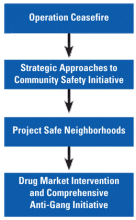Sidebar to the article Drugs, Race and Common Ground: Reflections on the High Point Intervention, by David Kennedy, published in NIJ Journal issue no. 262.
The story began in Boston in 1996, when an intervention called Operation Ceasefire largely stopped gang violence in the city. Operation Ceasefire combined problem-oriented policing with collaboration between law enforcement organizations and community stakeholders.
During face-to-face meetings, it was made clear to gangs that:
- If anyone in the gang shot someone, all members of the gang would receive attention from law enforcement.
- The community needed the violence to stop.
- Social services and other help were available for those who wanted off the streets.
Operation Ceasefire was associated with a 63-percent reduction in youth homicide (ages 24 and under).
In October 2000, the Strategic Approaches to Community Safety Initiative (SACSI) was launched. SACSI mirrored Operation Ceasefire in that it brought together law enforcement organizations, community partners and researchers to address crime problems. Most SACSI sites ended up working to reduce gun violence and using variations of the Boston model, but one site — Memphis — strived to lower the nation's highest sexual assault rate, with considerable success.
Project Safe Neighborhoods (PSN), established in 2001, builds from an evaluation of the strengths and weaknesses of the SACSI model. PSN creates partnerships among federal, state and local prosecutors; law enforcement; researchers; media and outreach specialists; and community leaders. It tailors the intervention strategy to the needs of each individual district and to the gun problem in that particular area.
The High Point Intervention (also known as the Drug Market Intervention) draws on the principles of Operation Ceasefire, SACSI and PSN to not only stop gun violence, but also to shut down open-air drug markets and the chaos that comes with them: the street sales, crack houses, drive-through buyers, prostitution, gunplay and the taking over of public space. A separate program, the Comprehensive Anti-Gang Initiative, is using a similar approach to address gang membership.
About This Article
This article was published as part of NIJ Journal issue number 262, published March 2009, as a sidebar to the article Drugs, Race and Common Ground: Reflections on the High Point Intervention, by David Kennedy.


